On a crisp September afternoon, President Antoinette M. Hays, PhD, RN, strolls the Regis walkways in a mask donned with the university logo. Normally she would be walking alongside a group of students. But like most universities, the campus is drastically different amid a pandemic. Seventy students—those who require in-person labs or clinical—returned to campus; they are tested for COVID-19 weekly. Under an outdoor tent, 51 nursing students are fit-tested for PPE equipment. The athletic fields, normally buzzing with energy on a typical fall day, are quiet. Still, Hays hasn’t lost her optimism because she knows that the Regis Pride is anything but quiet.
On the other side of this crisis, Regis will be even better and even stronger,” says Hays. “Faculty and staff have done an incredible job adapting to ensure our students continue to have an enriching educational experience this semester. And students—despite the disappointment that many are not on campus—are taking the situation in stride and continuing to excel in their remote classes and connect with classmates and faculty virtually.”
The “noises” on and off campus are different now, but not any less powerful. In July, the melodic beeps of a 3D printer mark the making of face shields to protect students in health sciences programs. In the virtual world of Zoom, the excited voices of professors are heard planning for a virtual exchange music course with a university in Mexico. At a student’s home, the rustle of a package being opened reveals an anatomy and physiology lab kit to conduct at-home dissections. Things are different, but moving forward.
The Protocol: Health and Safety
The decision to slow down the pace of Regis’ phased reopening this fall semester with primarily remote courses and limited access to residence halls came in August. As the spread of the COVID-19 virus across the country was escalating, health and safety were driving factors.
Since the pandemic began in March, there has been a continuous process of safety procedures and a constant revisiting of federal, state, and local guidelines related to the virus. After careful review of all factors, the decision was made to split the fall semester into two, eight-week terms, with most full-time students taking three courses in the first term (August 17 to October 11) and two courses in the second (October 13 to December 6). The goal was to provide flexibility to ensure that faculty and students could switch between remote and on-campus learning should circumstances shift.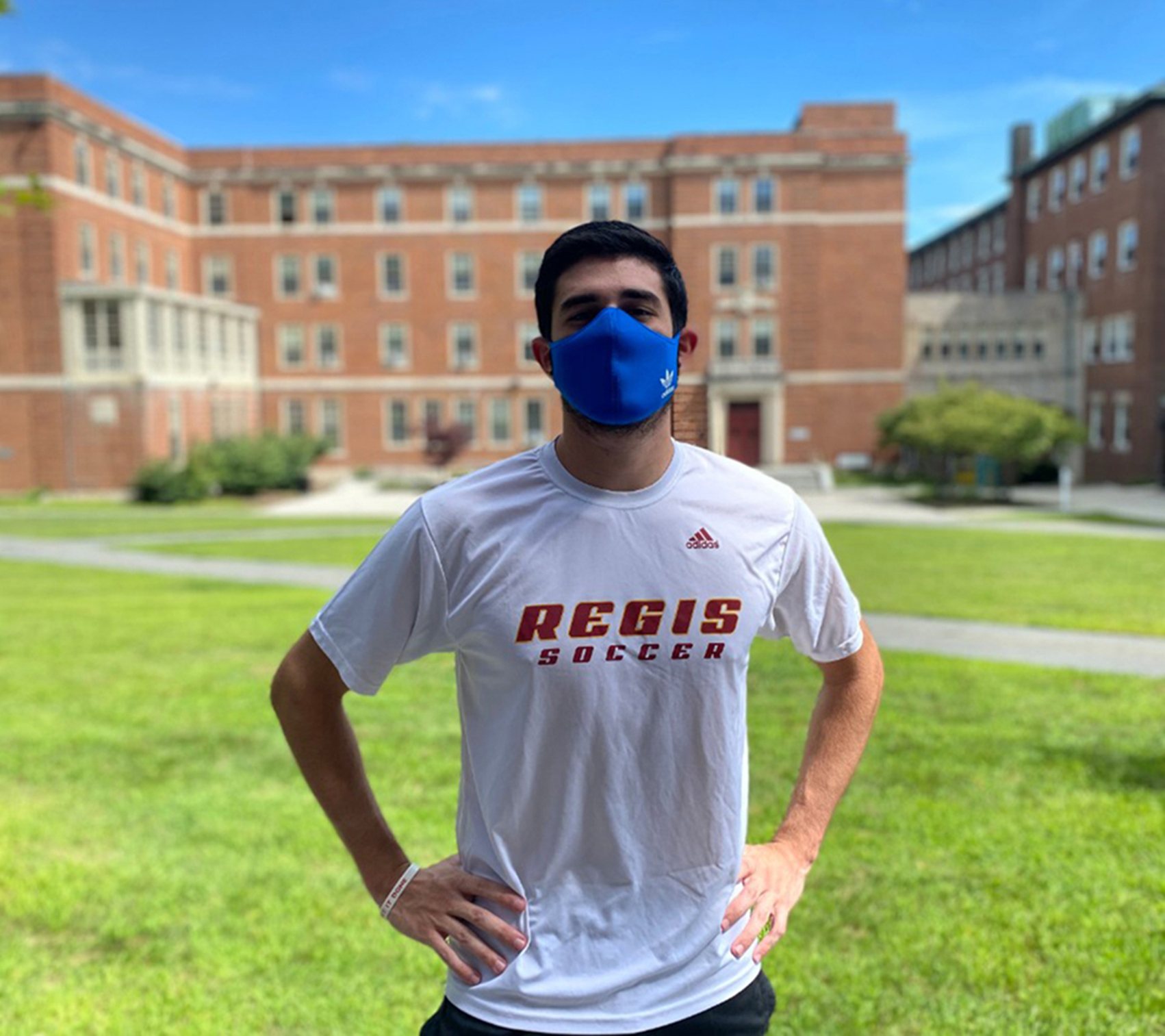
Limiting on-campus residential capacity ensured that the students living on campus all had a single-occupancy room. These 70 students required in-person and clinical experiences (all under appropriate safety guidelines) to make academic progress in nursing, dental hygiene, diagnostic medical sonography, and nuclear medicine. Only some courses in those undergraduate programs, as well as the graduate program in occupational therapy, met in person in a classroom or clinical setting this past fall.
Students, faculty, and staff who return to campus are subject to ongoing testing and safety protocols. Those living and working on the Regis campus are required to complete a daily symptoms screening. Regis Community Health Services (RCHS) will continue to operate with safety protocols in place. This includes no walk-in appointments and telephone triage prior to any scheduled onsite appointments. RCHS also provides telehealth medical appointments and collaborates with local urgent care facilities and Newton-Wellesley Hospital for after-hours and weekend care. The RCHS team continues to work in partnership with the Weston Board of Health regarding the ongoing COVID-19 testing program.
“Our goal at Health Services is to keep the campus safe and healthy. In order to do this, we need the participation of everyone on campus—this is a group effort,” says Associate Dean and Medical Director Dianna M. Jones, DNP ’11, CNP, FNP-BC. The Counseling Center provides individual counseling, groups, workshops, sports psychology counseling, and medication evaluation and management, all currently conducted by telehealth.
“I think most students would prefer to meet in person, but they find video counseling is nearly as good and has some advantages,” says Director of Counseling Kathryn Klickstein, LICSW. “With telehealth we do not have office space constraints. It allows students a lot of flexibility. For some students it has made it easier to keep their appointments and meet more regularly. Over the summer, we provided three times the normal amount of counseling appointments. This spring semester we will continue to offer remote services with in-person options as well.”
Hands-On, from Afar
 Regis faculty spent the summer taking best practices and lessons learned to develop a fall semester curriculum unlike any other. For courses that are more hands-on, such as labs, faculty worked to make sure students fulfill the lab components and achieve the course objectives.
Regis faculty spent the summer taking best practices and lessons learned to develop a fall semester curriculum unlike any other. For courses that are more hands-on, such as labs, faculty worked to make sure students fulfill the lab components and achieve the course objectives.
“Some students conducted experiments at home with lab kits, others utilized online interactive labs, while others critically analyzed experiments that faculty conducted on video,” says Leslie Bishop, PhD, chair of the STEM Department and a member of the remote lab task force.
Physics labs, for example, used PhET (physics education technology) simulation to help students understand concepts through the use of graphics and intuitive controls such as click-and-drag manipulations, sliders, and radio buttons. Though PhET isn’t something new for Regis, during remote learning it helped make data collection and the quantitative exploration of physics concepts more efficient.
“This system was a boon to both students and instructor, especially when Regis had to switch to online learning last spring,” says Professor of Physics, Astronomy, and Mathematics Santhosh Mathew, PhD. “Since Regis students were already exposed to PhET, the transition to online learning was smooth and quick. The independent nature of these resources guaranteed easy access to all of our students regardless of their physical locations.”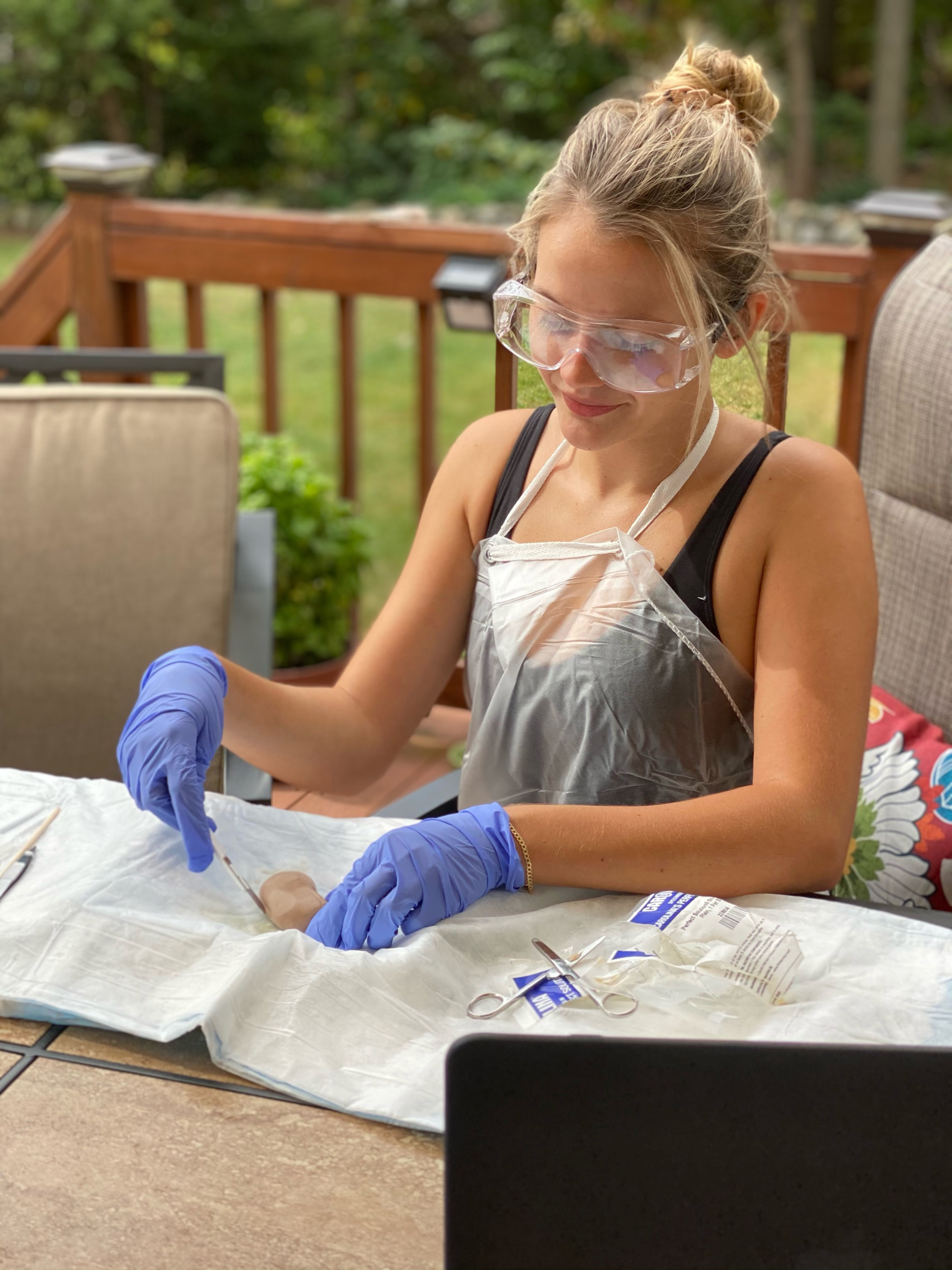
Anatomy and physiology (A&P) students conducted organ dissections with lab kits sent to their home. The kits supplied the preserved organ and dissection tools, instructions and diagrams, safety gear, and materials for proper waste disposal.
“The kits have dissection instructions, but I have the students follow along with their lab manual dissection instructions as they would do if they were in a lab on campus,” says Jeannine Foley, PhD, assistant professor of biology and coordinator of anatomy and physiology. Students in A&P had a sheep brain and cow eye; A&P II students had a sheep heart and kidney.
Biology major Emily Blanchard ’21 (pictured at right) dissected a heart and kidney. “I recorded myself during the dissection, cutting and pointing to the aorta or left ventricle in the heart and the kidney’s ureter or renal cortex. It’s cool to see an actual organ rather than just a diagram on a computer screen. I plan to pursue a career as a physician’s assistant, so this really sets me up for anatomy clinicals I’ll experience in the future.”
Seizing Global Moments
The move to remote learning has also provided a reason to continue building the virtual learning exchange that Megan Gibbons, PhD, director of the Center for Global Connections, was passionate about long before the pandemic. Globally connected classrooms feature a teaching method known as COIL (collaborative online international learning). Since Gibbons has spent the last five years working as a COIL faculty trainer, she was also able to support Regis faculty through the design phase of their work and connect them to their cohorts abroad to create the pilots by the fall.
“Virtual exchanges [VE] are technology-enabled, sustained, people-to-people education programs that employ a wide variety of platforms and educational pedagogy,” Gibbons says. “VE connects people to one another by designing activities that are collaborative in nature and often project-based. The work completed by students is, therefore, connected explicitly to learning outcomes predetermined by instructors or facilitators.”
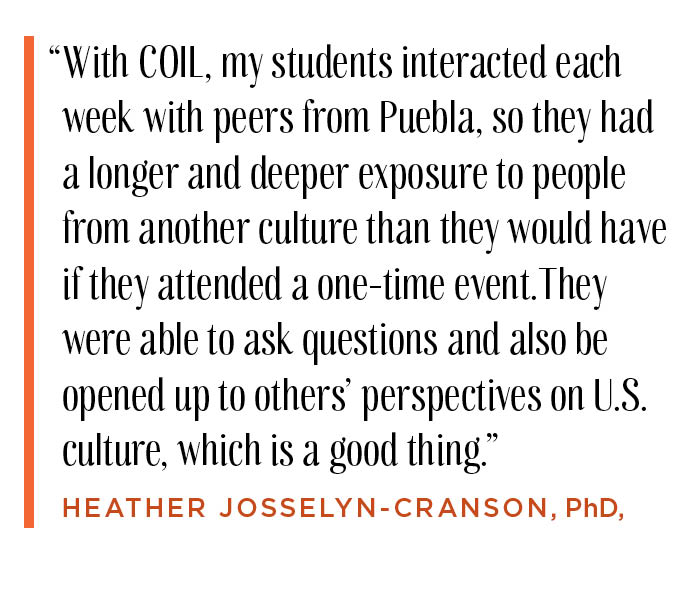 According to Gibbons, virtual exchange can be embedded into classes that are face-to-face, hybrid, or fully online, which makes it flexible. It also is dependent upon technologies—learning management systems, video conferencing software, and file-sharing, for example—that most institutions already use regularly. About 80 percent of virtual exchange work is asynchronous, an important consideration when multiple time zones are involved.
According to Gibbons, virtual exchange can be embedded into classes that are face-to-face, hybrid, or fully online, which makes it flexible. It also is dependent upon technologies—learning management systems, video conferencing software, and file-sharing, for example—that most institutions already use regularly. About 80 percent of virtual exchange work is asynchronous, an important consideration when multiple time zones are involved.
During the first term of the semester, Heather Josselyn-Cranson, PhD, Sister Margaret William McCarthy Endowed Chair of Music, taught Global Music, paired with a class at Benemérita Universidad Autónoma de Puebla in Mexico. Students explored the significance of music in different cultures. Among the assignments the Regis students completed with their peers in Mexico was an activity that asked them to examine recent chart-topping songs from both countries and discuss the accuracy of the respective cultural representations. The final COIL project was an exploration of the ways that music relates to family, education, government, or religion.
“With COIL, my students interacted each week with peers from Puebla, so they had a longer and deeper exposure to people from another culture than they would have if they attended a one-time event,” Josselyn-Cranson says. “They were able to ask questions and also be opened up to others’ perspectives on U.S. culture, which is a good thing.”
That kind of interaction was one of the favorite parts of the course for humanities major Noah Toumayan-Miller ’21. “It was nice to meet students from another country, learning about the history and culture of their music firsthand rather than just reading about it. We took a global journey where we learned background information about each of our destinations looking at the history and geography. We then looked at religious and cultural considerations, the history of the music styles, the instruments, the singing styles, and the purpose of the music.”
Assistant Professor of Humanities Jennifer Potts taught the virtual exchange course Exploring Humanities, teaming up with a course at Universidad Pontificia Comillas in Madrid, Spain. Students studied the state of immigration in both countries, including a project using a chosen medium, such as a brochure, children’s book, or podcast, to share and explain different viewpoints about immigration.
“During this pandemic experience when students do not have the opportunity to study abroad, I believe that it is more critical than ever that students understand that they are part of an international community and that they develop the cultural competencies necessary to live and work in a global world,“ Potts says. “We want this to impact the way they think about the world.”
A New Presence
The dental hygiene program operated hybrid this fall, with remote didactic courses such as dental anatomy and pharmacology and in-person labs and clinicals in the Regis Dental Center in Waltham to complement theory with practice.
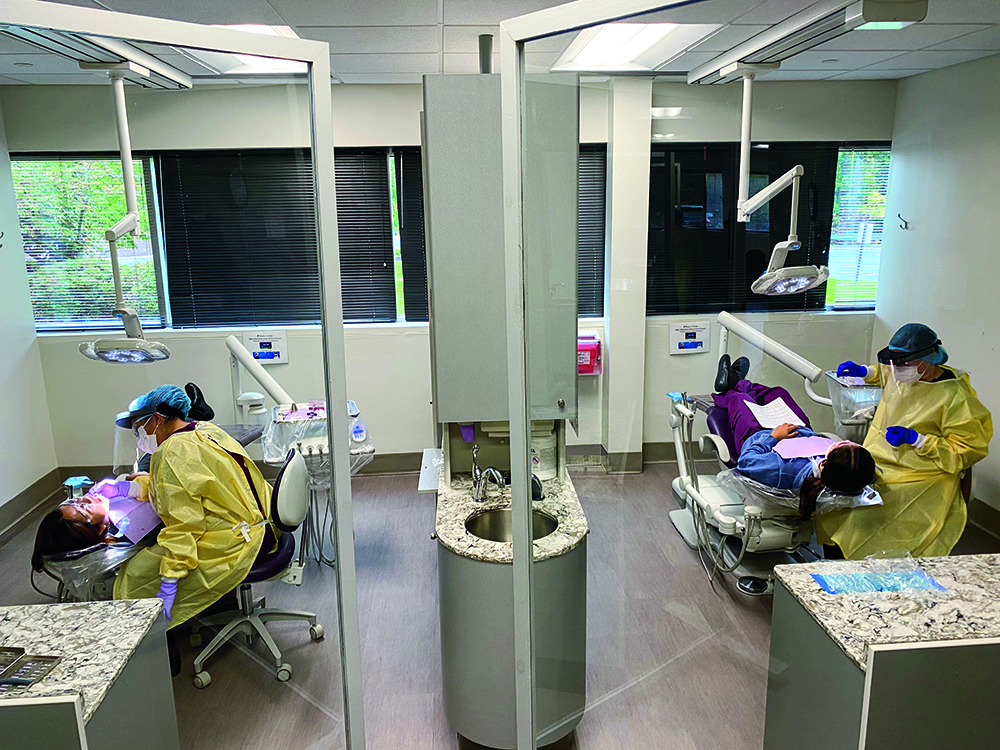 Donned in PPE at the Dental Center, students in Dental Hygiene Clinic I, for example, worked on typodonts (models of the oral cavity) to learn practices such as proper positioning and using periodontal instruments. (Pictured at left) The center opened for patients in August.
Donned in PPE at the Dental Center, students in Dental Hygiene Clinic I, for example, worked on typodonts (models of the oral cavity) to learn practices such as proper positioning and using periodontal instruments. (Pictured at left) The center opened for patients in August.
“These are unprecedented times, but our students stepped up and did a great job,” says Karen D. Hallisey-Pesa, DMD, program director and associate professor of dental hygiene. “A silver lining of COVID-19 is that our students were even more appreciative of their time in the clinic, especially given how quickly everything stopped back in March. Students have really made learning a priority and understand how precious it is to have that time in the lab and clinic.” “Instructors are trying really hard to make sure that we all feel safe and protected,” says dental hygiene student Karolina Urbe ’21 of being in the clinic. “It was hard getting used to wearing additional PPE and it does cover us from head to toe—masks, gloves, hair covers, loops, face shields, booties, and special lab jackets, for example. There are so many things we need to think of before we do anything, whereas before the pandemic it was a natural process. The “new normal” really feels different, but I believe we all are doing well in getting used to it.”
The pre-licensure nursing department was fully engaged in clinicals this fall, according to Donna Glynn, PhD, RN, ANP, associate dean of pre-licensure nursing and associate professor.
“The hospitals reopened to students in July so our accelerated BSN/MSN students were back in the hospitals in July,” Glynn says of the Bachelor of Science in Nursing (BSN) to Master of Science in Nursing (MSN) program. “Seventy students were placed in their preceptorship for the fall. To prepare, we performed mask fittings for students with Dan Scanlon, paramedic and EMT supervisor at Fallon Ambulance.”
Although no student nurses were assigned to COVID-19 patients during clinical, they completed all of the COVID-19 requirements from the hospitals.
“This experience was different because masks and face shields were previously not involved in giving care, and now it feels wrong that we did not wear them before,” says nursing major Alexa Petkewich ’22 of the clinical experience at Lahey Burlington. She also works as a patient care associate at Mass General Brigham in Boston.
Kayla Volkov, who completed her Regis BSN in 2016 and is working toward an MSN (nurse practitioner), has had many different classroom experiences at Regis over the years: in-person, online, and hybrid courses. But she says she really felt the effects of COVID-19 on the learning environment during the summer.
“I was enrolled in Advanced Health Assessment and despite not being able to meet in person to practice physical exams, we made the best of it,” Volkov recalls. “My husband was my ‘patient’ and via Zoom, my professor was able to give me guidance and make the experience a good one.”
In June, Volkov participated in a simulation lab on campus for a one-on-one experience. “I was able to safely learn how to do a speculum gynecology exam with a simulation manikin. My gynecology preceptor said how impressed she was with how well I was doing and my comfort level independently performing the exams.”
She looks forward to more in-person simulations. “I thrive on learning in person and interacting with my professors and peers because it is so important to get as much hands-on learning as possible.”
Petkewich, who lived on campus this fall, says that resident assistants held events to help students stay connected, and that the dining staff “was incredible.” “Even though there was not as much happening on campus as there was pre-COVID, the small group of people who were there still had the same spirit.”
Uncovering Pandemic Truths
Regis course launched in fall 2020 examines the COVID-19 pandemic—and the social disparities it has highlighted—through multidisciplinary lenses, including virology, communication studies, public health, and art.
The idea for the course—Living and Dying in the Pandemic—came from Vice President for Academic Affairs Mary Erina Driscoll, PhD. Mary Lou Jackson, PhD, special assistant to the president for mission, spearheaded the initiative with faculty representatives from all four schools—the School of Arts and Sciences, the Marshall M. Sloane School of Business and Communication, the School of Health Sciences, and the Young School of Nursing—as well as staff from the Center for Global Connections, the Center for Ministry and Service, and the Center for Inclusive Excellence.
“I’m grateful to Mary Lou, who brought together a talented group of faculty over the summer to create a course that offers an in-depth examination of the pandemic using multiple perspectives,” Driscoll says. “It’s exactly the kind of mission-driven, intellectually rooted effort that’s possible when you have the rich resources of faculty expertise and creativity that Regis enjoys.”
“Everyone on this team is so collaborative and intelligent in their fields,” says Assistant Professor of STEM Shannon Hogan, PhD. “They all have a deep understanding of how what they do has a global impact and interacts with each other’s disciplines.”
The course includes open forums that move across disciplines. One gives students the chance to read personal narratives related to the mental health impact of the pandemic.
“In the Humanities Department, we created a field of study for students who want to focus on medical humanities, which is an emerging field that considers traditional humanities disciplines in the context of medical education and practice,” says Jonathan Fitzgerald, PhD, assistant professor of humanities and general education. “I felt that a medical humanities perspective would be essential to the formation of the course.”
 For Professor of Public Health Leslie Mandel, PhD, the course not only brings more attention to her field, but also takes a hard look at the social disparities and inequities that COVID-19 highlighted. “The pandemic brought more attention to an already bad situation. We want this to be a jumping-off point for students so they can learn how, through policy and advocacy, they can make constructive change.”
For Professor of Public Health Leslie Mandel, PhD, the course not only brings more attention to her field, but also takes a hard look at the social disparities and inequities that COVID-19 highlighted. “The pandemic brought more attention to an already bad situation. We want this to be a jumping-off point for students so they can learn how, through policy and advocacy, they can make constructive change.”
Marisa Carrasquillo ’22, a public health major at Regis North, says she enrolled in the course to learn about pandemics from the experts. “I wanted to learn how to navigate during COVID-19 and explore ways I could impact this kind of work in the future as a public health professional,” says Carrasquillo, who is an analyst at Blue Cross Blue Shield of Massachusetts and also volunteers with underprivileged members of the community. “The course has delivered more than I expected, particularly regarding the vital importance of public health professionals not just in the U.S. but worldwide. Countries that quickly acted with the guidance of public health professionals have been able to contain the virus. Germany is a great example of how policymakers and public health professionals can work together during a pandemic efficiently and effectively.”
Shielding the Front Line
Assistant Professor Brian Plouffe, PhD, founder and undergraduate director of biomedical engineering, received a unique summer project assignment this year. With access to a new 3D printer in the Watson-Hubbard Science Center thanks to generous gifts from Board of Trustees Chair John J. Tegan Jr. and Board member Paul Lonergan, Plouffe was asked if he could print face shields for health sciences students.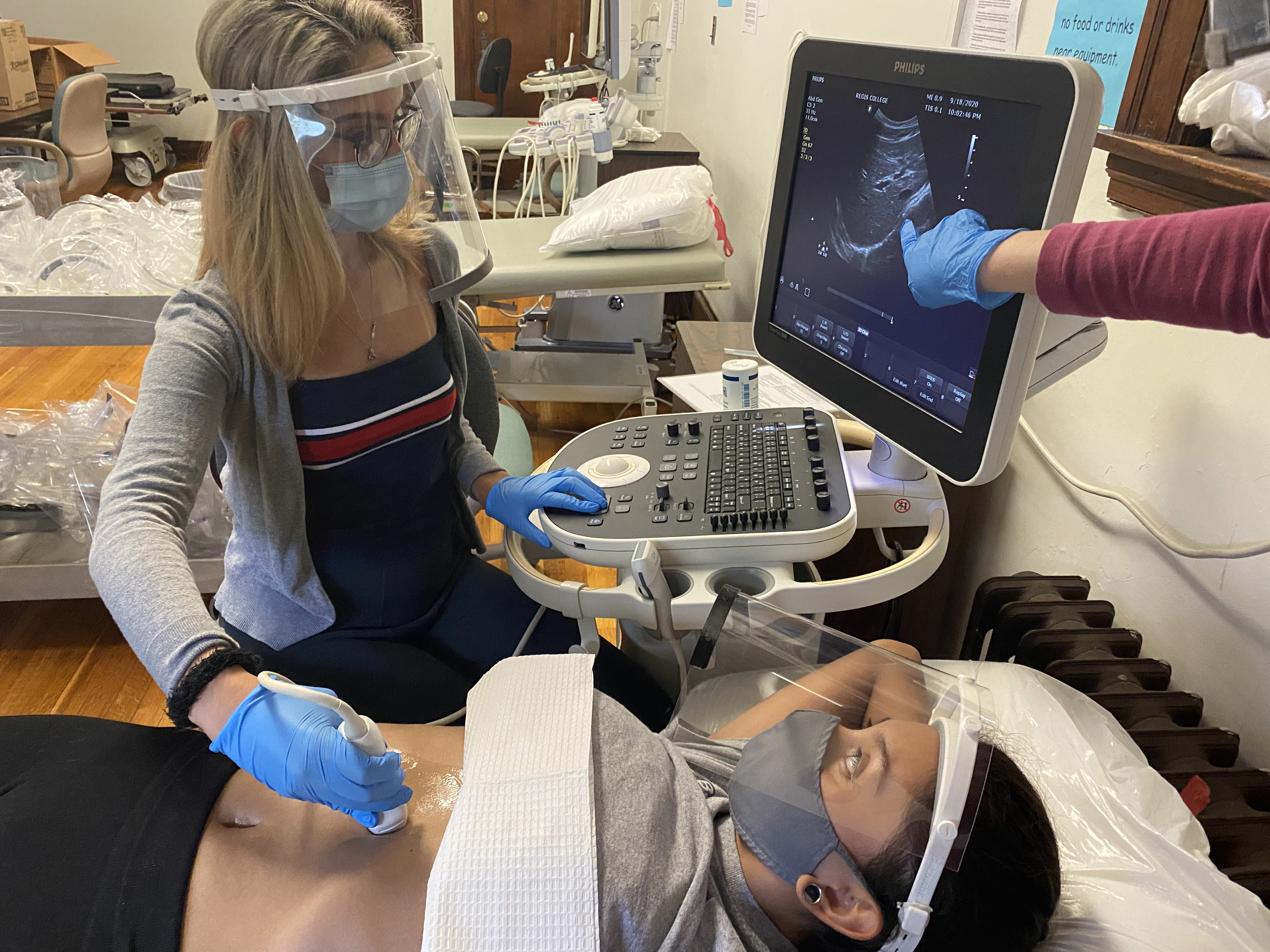
The face shields were distributed to diagnostic medical sonographer students, occupational therapy students, and others in the health sciences programs who were enrolled in clinicals during the fall semester. (Pictured at right)
“I am truly proud of the collaboration this summer between the School of Arts and Sciences and the School of Health Sciences,” Dean of the School of Arts and Sciences Kathryn Edney, PhD, says. “The work that Brian is doing exemplifies everything that Regis stands for, as well as the value of interdisciplinary thinking, especially during these unprecedented times.”
A 3D printing novice, Plouffe said he went through three different design templates before he found the one he felt worked best. The shields are made of polylactic acid, one of the most common materials used in 3D printing. Since July, Plouffe was able to print about 30 face shields.
“I come from more of a chemistry background,” Plouffe said of his learning curve. “But there is a lot of information out there and readily available.” He video-recorded the shield-making process to share with students for future assignments.
When it is not creating face shields, the 3D printer will be used by biomedical engineering students for their senior-year final project, which includes working with doctors, patients, and other end users in the health care industry to develop a product to solve a problem.
Previously, students would only be able to sketch out their ideas and explain a product’s potential impact. Now, students will be able to print out models and demonstrate their capabilities.
“Having an actual object has much more impact on learning outcomes,” Plouffe explains. “It gives the students ownership.”
Game Plan
NCAA regulations prevent formal student-athlete training without medical clearance that’s usually reviewed by a college’s athletic trainers—a hurdle for many during the COVID-19 pandemic. Regis coaches have encouraged their teams to be creative and provided some strategies to stay on task while they’re working remotely.
“The biggest thing that coaches can do while we are remote during the pandemic is to help student-athletes create their study environment and develop good study habits, even though they aren’t in a classroom,” says Renato Capobianco, head coach of the Regis men’s soccer team and director of strength and conditioning.
Capobianco developed the B12 Plan to help (see sidebar). Its guiding principle: Plan to get your responsibilities done before noon. The afternoon can then be used to finish up leftover tasks and allow for personal free time before heading into the evening’s study sessions.
“How a player behaves off the field is probably how they are going to behave on the field,” Capobianco says. “Playing sports is about learning to overcome adversity. If players can learn how to deal with this health crisis, it’s going to be easier when they get back on the field—because they did what they were supposed to do in the most challenging of times.” —Contributor Joseph O’Connell
B12 Plan
Renato Capobianco, head coach of the Regis men’s soccer team and director of strength and conditioning, created the
B12 Plan to help student-athletes succeed academically while working remotely during the COVID-19 pandemic.
Plan, prepare, prioritize.
Use Sunday evenings to get an overview of the upcoming week. Determine what will require the most time and what resources you will need (study sessions, tutoring sessions, meeting with the professor) to get that task/assignment accomplished.
Create your work/study environment.
Find a place that is quiet and conducive to getting work done and is free of distractions. Create the “Daily To Do List.” Check off tasks as they are completed and (if possible) don’t stop until all the tasks are done. Tip: Date your lists for better tracking and start each morning by checking the prior day’s list to see if there is any unfinished business to complete.
Have a clear understanding of the task/assignment.
Know exactly what is needed to complete the task/assignment. Know exactly what the “finished product” should look like. Follow through. Getting a task started is easy; but making sure it’s completed is the ultimate goal! Once you take on a task, you are responsible for making sure it has been accomplished.
Eliminate distractions.
Your phone and its access to social media is by far your worst enemy. Get in the habit of only opening/responding to emails that will assist you in
getting your tasks completed. All other emails/texts will eat up your valuable time.
Develop and stick with your routine.
The key to staying on task is creating a comfortable routine to put you in the best environment for success. Don’t try to multitask or set unrealistic daily goals. Be disciplined about getting your “Daily To Do List” done before noon, day in and day out.
Read more articles
Read the entire magazine online